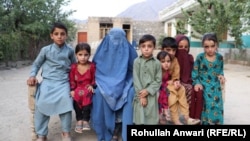MARAWARA, Afghanistan --- Maryam, an Afghan grandmother, is surrounded by her eight orphaned grandchildren inside their modest house in a remote village in eastern Afghanistan.
As Muslims across the world celebrated the Eid al-Adha festival this past weekend, the 48-year-old spent most of her time visiting the graves of her three sons and trying to console their children.
Maryam’s sons were killed in a suicide attack in Asadabad, capital of eastern Kunar Province, more than four years ago. Her only surviving son was also injured in the attack.
Wearing a blue all-enveloping veil, Maryam told Radio Free Afghanistan she thought she would die of the agony from first learning about the killing of her three sons.
She recalled how she felt on the morning of February 27, 2016 -- the day her three sons were killed. "It was a day from hell," she said. "I began hearing screams and felt as if the sky was falling and the ground beneath my feet was slipping away."
That day began like any other for her four sons. Ihsanullah, Habibdullah, Roohullah, and Muhammad Jaffar left their house together as they often did. The three elder brothers made a living selling fritters, fries, and soups out of a makeshift shop on a busy square near government offices in nearby Asadabad while Jaffar attended a local school.
But a suicide bomber riding a motorbike attempted to target the entrance of the governor’s compound, and the three elder brothers were killed in the blast, which killed other 16 Afghan civilians and injured 40 more.
Jaffar survived the blast, but it crippled his right hand. The bomber struck before he could say goodbye to his elder brother as they were busy preparing food for the day.
“This tragedy has taught me that peace is the most precious gift,” Maryam said. “I now pray that other Afghans families must not experience the misery, suffering, and agony we are enduring.”
Her husband, Muhammad Azim, 52, says the tragedy has forced him to return to hard labor to feed his family. “I am old and weak and have no skills, business or another stable source of income,” he said. “I have no choice but to accept my fate.”
Azim’s house stands atop a gray, rocky hill in Kunar’s rural district of Marawara. His three sons are buried across from his front yard. Across Afghanistan, graveyards are regularly filled with the victims of the seemingly endless war that began after a bloody communist coup in April 1978.
In most Kunar graveyards Afghan soldiers, Taliban fighters, and their civilian victims are buried next to one another. Some are even members of the same extended families.
Maryam’s family now hopes the Afghan government and the Taliban can find a way to make peace. Beginning on July 31, the two sides engaged in a three-day cease-fire to mark Eid al-Adha. It is not yet clear whether they will extend the armistice. The two sides are also expected to engage in peace negotiations stipulated in an initial peace agreement between the Taliban and the United States, which was signed in February.
The United Nations Assistance Mission in Afghanistan has documented some 3,458 civilian casualties during the first half of the current year. These include 1,282 killed and 2,176 injured.
While the figures represent a drop in overall violence compared with the previous years, the Afghan Independent Human Rights Commission says that on average 16 civilians have been killed or wounded daily across Afghanistan during the first six months of 2020.
Such high levels of violence make Afghanistan one of the deadliest conflict zones in the world.
Abubakar Siddique wrote this story based on Rohullah Anwari’s reporting from Marawara, Afghanistan.










